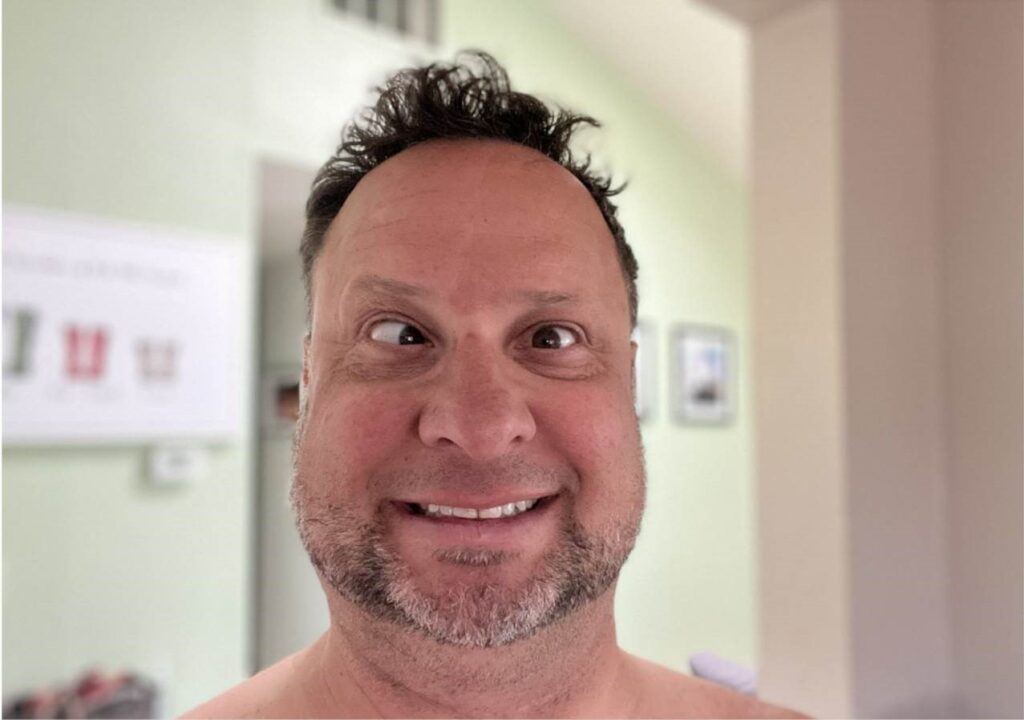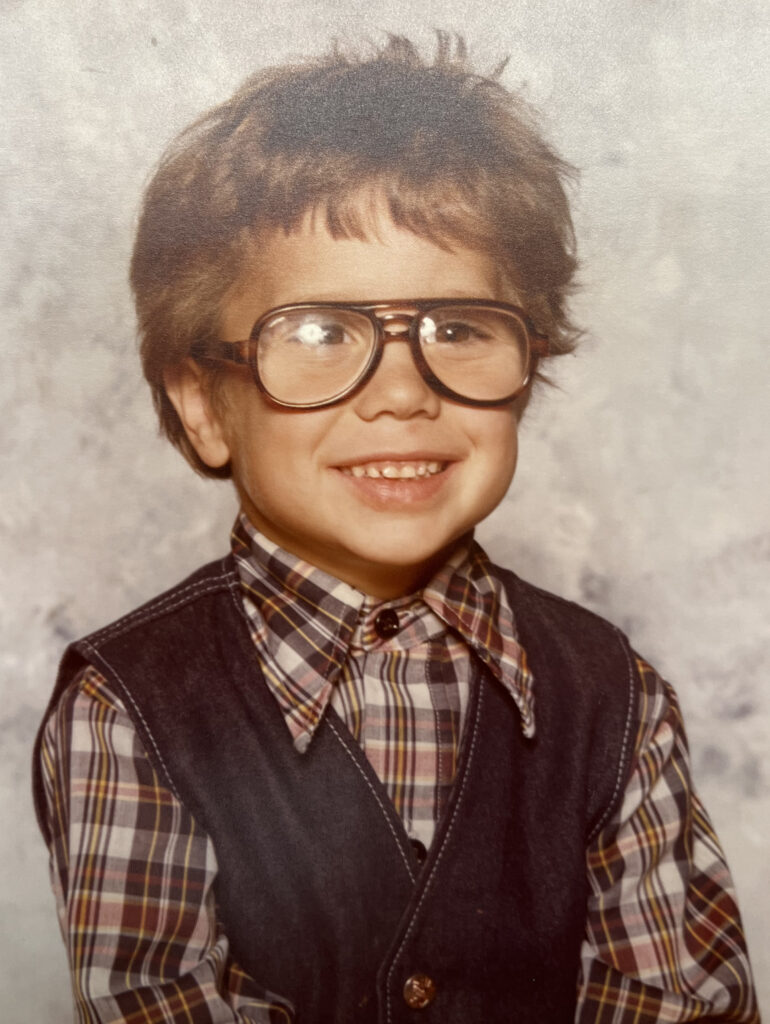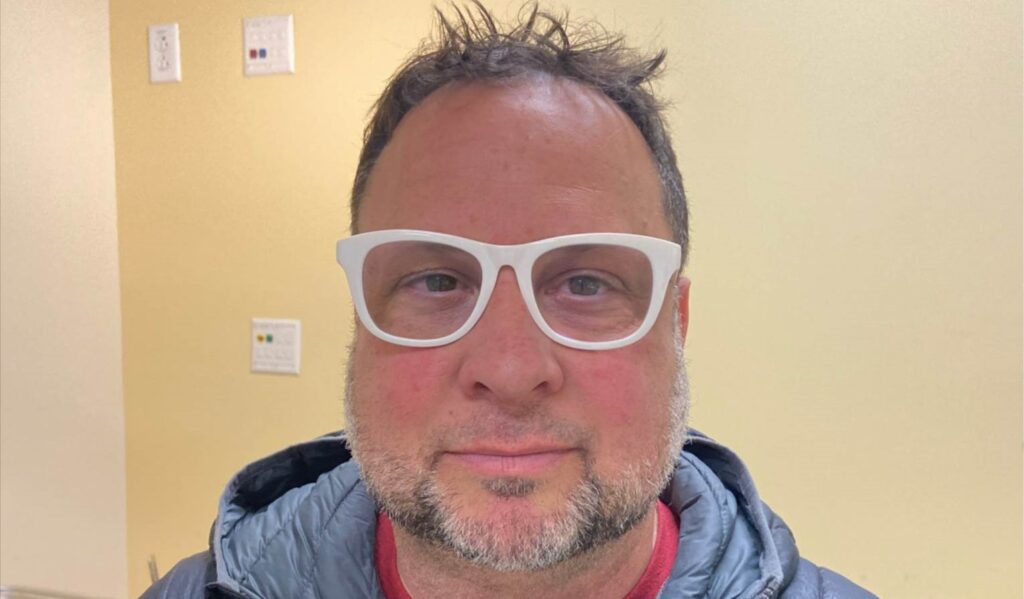Antioch Kaiser eye doctor helps man see straight for first time since childhood

“Strabismus” could affect as many as 30,000 people in Contra Costa and is correctable
“I look at the picture and go ‘wow’! I just feel good.” – patient Kyle Emard
“It’s an out-patient surgery. You go home the same day.” – Dr. Daniel Greninger
By Allen D. Payton
After living with being both cross-eyed and deaf for most of his life, 49-year-old Kyle Emard can now see straight thanks to the talent and skills of Kaiser Permanente ophthalmologist, Dr. Daniel Greninger whose office is in Antioch. He corrected Emard’s vision impairment known as strabismus.
“After I was born my eyes would look straight ahead. But when I was five, my eyes started to go inward,” Emard shared through a sign language interpreter. “My mom asked me if I wanted surgery. I said, ‘no, no’.”
And he never did have the corrective surgery, until last year.

“I never had any bullying,” Emard said. “I was playing football, wrestling and traveling all over the country. My grandfather had a travel agency. It didn’t bother me. People would ask me what was wrong with my eye. They thought I was blind in one eye. During conversations people would look past me, not sure which eye to look at. I’d think, ‘they’re not looking at me’. I’d say, ‘I’m looking at you’.”
“I graduated from high school. I got ready for college. Then I bought a house,” he continued. “My mom asked me, again if I wanted surgery, and I told her ‘no’.”
“Strabismus describes eye misalignment problems,” Greninger explained. “In Kyle’s case this is most likely attributed to accommodative esotropia. That’s a condition where a person’s eyes turn in excessively due to them trying to focus. Kyle is far sighted.”
“This is very common for eye misalignment problems,” the doctor added. “People have a hard time looking at those with strabismus.”
“Sometimes it would be a serious discussion and people would say, ‘look at me’, And I was,” Emard shared. “It was annoying.”
“For some people it’s more than annoying,” Greninger interjected. “For people with strabismus it’s a quality-of-life impact issue.”
“What is particularly unique for me from the doctor’s side of it is Kyle also has hearing impairment. He has to communicate visually,” he continued. “Sometimes people with strabismus and hearing impairment have double vision. Sometimes depth perception is affected.”

Emard began wearing his first pair of glasses when he was five years old. But his vision progressively worsened, through the years.
“Kyle mainly looked out of one eye,” the doctor shared. “But surgery was done on both eyes. More on the right eye than the left.”
“For people with hearing impairment it’s called Usher Syndrome in which people have both hearing and vision impairment,” Greninger continued. “People assumed Kyle had that. Usher syndrome is a completely different genetic condition in which patients often have very significant hearing and vision deficits and are often functionally blind. In Kyle’s case, I think people knew he was deaf, and then saw his eye drifting and assumedthat he also couldn’t see due to Usher syndrome, which would be incorrect.”
“People assumed I was blind in one eye,” Emard shared.
Asked if it was difficult to read a book, watch TV or go to the movies, he said, “No.”
“His sight was fine. He could see 20/20 but he was only looking out of one eye,” the doctor replied. “If you have strabismus as a child, often the brain learns to ignore one eye to avoid seeing double. In adults, acquired strabismus can often result in double vision. Kyle’s problem, accommodative esotropia, typically develops between 2-6 years of age, and is related to hyperopia, or far-sightedness.”
Emard said he continued to wear glasses, then mainly contacts in high school. He went snow skiing, snowboarding and dirt biking.
“I wouldn’t go up high places, just small hills,” he shared. “I played roller blade hockey, defensive end in football. That was all before.”
A graduate of Leigh High School in San Jose, Emard attended Gallaudet University in Washington, DC.
“It’s one of the best known colleges for the deaf. All the instruction is in ASL (American Sign Language),” Greninger added.
“It’s a muscle issue. There are six muscles that are attached to the eye that move it in different directions. Up and down, left and right, and torsion that twists the eye,” he explained. “In strabismus, sometimes it’s a disease of the eye muscles. More commonly it’s the brain not telling the eye to do something. Our brains are usually hardwired to know how much to turn to focus.”

The Surgery
Asked when he decided to have the surgery Emard responded, “After my mom passed away three years ago. My family had money. Everything I was doing was done for the deaf organization. I felt it was the right time.”
The surgery took place last September.
“I met Kyle in 2022 after I had received a referral from one of my colleagues, a consult request. We set up a video chat with an interpreter,” Greninger shared. “We do video consults, first. For this condition it’s important for me to know the history of the condition.”
“We had that first video visit. We used some remote tools which allowed Kyle to take photos and videos at home,” the doctor continued. “We were able to use the components of technology that we didn’t have five years ago. I then had him come in for a complete eye exam to make sure his eyes were healthy.”
Asked if the technology is better, Grenginer said, “It’s safer, now. It’s about an hour-and-a-half surgery.”
“I can’t go into the brain and turn a screw a quarter inch to change how the brain controls the eye,” he explained. “So, we put in an eyelid speculum, we make a small incision over the eye and we find where the eye muscle is. It’s red and very small. We put in a small suture, like a stitch where the muscles connect to the white of the eye. Then I detach the muscle with surgical scissors and move it to a new position. If we move it back that creates some slack and decreases the force on the eye for turning.”
“I wear special surgical loops to help me see. But it’s all done with hands no lasers,” the doctor stated. “The amount we move the muscles is determined by the measurements we take in the office. Deciding which muscles to move and in which pattern based on the person’s problem are the intellectual work of my specialty.”
“I don’t want to over-compensate or under do it,” he continued. “It’s done in millimeter precision. We’re measuring the half-millimeter. Each millimeter moves the eye three degrees.”
“I knew I was nervous out of fear of losing my eye,” Emard shared.
“Each time I saw you I was more comfortable,” he said to the doctor.
“I don’t remember the surgery. When I woke up, I thought, ‘I’m ready’. But I looked and was shocked,” Emard exclaimed.
“It’s general anesthesia surgery so you’re asleep the whole time,” Greninger said. “We were able to get a sign language interpreter to be there in Walnut Creek the whole day, which I think is very important to give people the same level of care. I was really happy the leadership and nursing staff were able to provide that.”
“We had to move three muscles on Kyle’s eyes. One muscle on his left eye and two muscles on his right eye,” the doctor explained. “First, we relaxed the muscle on the left eye. Then on the right eye we tightened the outside muscle and relaxed the inside muscle.”
“I remember the right eye was much more red than the left,” Emard explained. “After surgery I did have double vision for a little while but then it went away. I had full vision. I could see all the way around. It was strange.”
“After the surgery I felt the same,” he added.
He used eye drops for a few a days, “but the redness lasted a few weeks,” Emard shared.
Asked how long the recovery time is Greninger said, “About six to eight weeks. I usually tell patients in two months’ time people won’t be able to tell they had the surgery. Kyle came back to see me about six months later to see if everything was fine, about March of this year.”
“Sometimes I forgot. ‘Did I have surgery?” Emard stated. “I posted and let everyone know on Facebook and showed the before and after photos and got almost a thousand likes. After my surgery I cried a lot because my mom wasn’t around to see it. But she’s happy, now.”
Emard lives in Livermore, works in Fremont as a middle school counselor and has one child, a 15-year-old son.

Asked what his son thought Emard said, “He said ‘wow!’ He was shocked. He just kept looking around my eye, opening my eye. He was used to looking at me inward.”
“On the day of my surgery my son was at school, and he was all worried. He said my dad’s fine and the teacher said, ‘good’. The week after he had a football game and my friend drove me. I sat alone by the goal post. I told people I didn’t want to talk yet I’m still healing. But I had to be there.”
Asked if it has impacted his job Emard said, “It’s about the same” then spoke of the difference between the school pictures from last year compared to this year.
Asked if he feels different about himself, he said, “Oh, yes. I look at the picture and go ‘wow’! I just feel good.”
“After surgery my friends were gathering and said they missed my lazy eye,” Emard said with a laugh. “I’m happy every day.”
Asked if people who have the surgery get counseling after, Dr. Greninger said, “The psycho-social impact of strabismus has been well studied. Characters in movies with strabismus often are portrayed with other disabilities, and people may wrongly assume that all people with eye misalignment have other intellectual handicaps. Studies have shown that childhood strabismus can negatively impact a teacher’s perception of a student’s motivation or focus. In addition, strabismus in adulthood can sometimes be a barrier to success in the workplace or finding a romantic partner.”
“Even the term lazy eye – we don’t use that term,” he continued. “Some people despite having strabismus they use the term lazy eye. It has a certain connotation to it. We think if it as a negative There’s a misunderstanding of people with strabismus.”
30,000 County Residents Have Correctable Vision Impairment
With offices at Kaiser Permanente Antioch Medical Center on Deer Valley Road, Dr. Greninger grew up in San Ramon, graduated from Cal High and earned his undergrad at Dartmouth College. He did his residency at UCSF Medical Center in Ophthalmology followed by a Fellowship in Pediatric Ophthalmology and Adult Strabismus at Oregon Health Science University in Portland.
“I started at the Antioch Medical Center in 2013. It’s been about 10 years of offering the surgery in Contra Costa County,” the doctor shared. “About half of my practice is adult strabismus and about half are children. We do about 100 to 150 surgeries like this each year.”
“We estimate we have about 15,000 with eye misalignment problems in our service area,” Greninger stated. “Sometimes people can have a medical problem like a stroke, thyroid eye disease, a neurological condition or facial trauma from an accident or assault. They can cause eye alignment problems. Probably half my adult patients had it as children and it either came back or it was never dealt with.”
He also estimates there are as many as 30,000 people in Contra Costa County suffering from strabismus which is correctable.
“Many people have this and don’t know something can be done or has been on the back burner for a long time,” Greninger stated. “Sharing stories like Kyle’s is good to let people know something can be done. I have patients come to me and say, ‘I wish I had come to you earlier’.”
“I try to put myself in the patient’s shoes to see how they’re thinking. It’s a leap of faith for a patient. It takes a lot of bravery to trust a doctor with your eyesight,” he said.
“It’s an out-patient surgery. You go home the same day. Most of the eye surgeries are done in Walnut Creek,” Greninger added.
the attachments to this post:

Patient Kyle Emard & Dr. Daniel Greninger
























